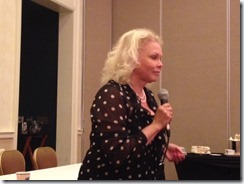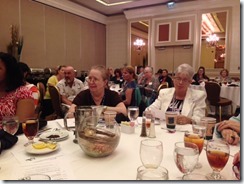At the March meeting of Mystery Writers of America Florida Chapter, bestselling author Joanna Campbell Slan spoke for an hour on how to be a great speaker. Her talk was riveting and the perfect example of what she was saying. She should know. Joanna has been named by Sharing Ideas magazine as “one of the top 25 motivational speakers in the world.” Her personal essays have appeared in the Chicken Soup for the Soul series, and one was made into a television program on the Pax Network. So here are her tips:
 Tailor your introduction to meet the needs of the audience. What connection do you have with this group? Praise them for their work. What have they done that makes your life better? Practice out loud. It gives you muscle memory.
Tailor your introduction to meet the needs of the audience. What connection do you have with this group? Praise them for their work. What have they done that makes your life better? Practice out loud. It gives you muscle memory.
Before you speak, listen to group dynamics to learn what’s going on. This will also predispose people to like you. When addressing the group, “Charm their socks off.” When you reference people you’ve met who are in the group, you close the gap with the crowd. “It was great to sit with Mary today.” Listeners want a connection.
The group wants to learn about you as a person. What can they gain from hearing about your experiences?
Mention the importance of a signed book, how it might inspire a younger person to read or to write stories someday. If your readers aren’t in the audience, instill good will so the listeners want to take home a piece of you or give your book to someone who loves to read. A physical book can be kept as a souvenir or passed on.
Anything you can do wrong has already happened to someone more important. The audience is rooting for you to succeed. Nobody expects perfection, but they don’t want you to waste their time either. What can you do that benefits them? Regarding handouts, people often keep them for years.
Prepare your introduction. Prepare a testimonial that relates to your expertise. Find someone in the audience who can back up your claims. Prepare something fun, like putting sticky notes under a chair so someone wins a prize.
Catalog your personal anecdotes and practice them. You shouldn’t be the hero of your own story all the time, i.e. “I did this and everyone loved me.”
Get the audience engaged by asking them a question. Perform an activity, like asking them to speak to a neighbor or write something down on an index card. End your talk with a call to action, i.e. sign up for your newsletter. Hand around a slip of paper and offer a freebie for people who sign up. Or do a special offer: If you buy 5 books, I’ll donate one to your library.”
Now to go practice what Joanna taught us….
<><><>
Joanna’s first mystery novel—Paper, Scissors, Death—was an Agatha Award finalist. It features Kiki Lowenstein, a spunky single mom who lives in St. Louis. Joanna’s next series—The Jane Eyre Chronicles—began with Death of a Schoolgirl and continues with the release of Death of a Dowager. Her newest series—the Cara Mia Delgatto Mysteries—is all about second chances. Tear Down and Die and Kicked to the Curb are just the beginning. The college textbook Joanna wrote—Using Stories and Humor: Grab Your Audience—has been praised as an invaluable resource by Benjamin Netanyahu’s speechwriter and has been endorsed by Toastmasters, International. http://www.joanna-campbell-slan.com/














